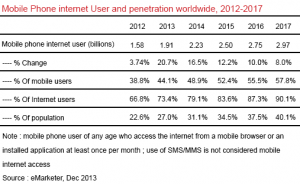Mobile technology has played a major role in transcending boundaries in technological advancement. As year passed by, more opportunities are offered by mobile technology in the area of consumerism, GPS, online experience, and gaming. Business and companies have utilized these to market their services and products to better their advertisement and increase their revenue.
Here are four reasons to go mobile for your business.
1) Most people have smartphones and access to the Internet.
According to eMarketer, 4.55 billion people all over the world will be using a mobile phone in 2014. Furthermore, between 2013 and 2017, an increase of 61.1% to 69.4% of the global population will be seen on mobile phone usage. eMarketer also estimate that the total number of mobile phone internet users will rise 16.5% in 2014 and maintain double-digit growth through 2016.
2) Another form of advertisement and marketing method.
Mobile applications have been one of the innovative inventions in today’s history. Almost 70% of the world’s population has smartphones, and access to the Internet has never been easy via the Wi-Fi technology. These factors led to mobile applications as a form of advertisement and marketing method.
Consumers spend more time on their smartphones rather than on their computers. Most features of the computer are also incorporated into smartphones, with smartphones having unique features of its own. Businesses and establishments who go mobile are likely to increase their return of investment and annual profit.
Apple Inc. launched the iBeacon technology which it calls “a new class of low-powered, low-cost transmitters that can notify nearby iOS 7 devices of their presence.” iBeacon helps smartphones and other iOS 7 devices show notifications of items and services that are on sale, and it can be used to make payments for purchased goods. This technology offers the mobile enterprise an ample amount of opportunities to explore and grow.
3) Increase brand perception by target audience.
Going mobile through the use of mobile website or by creating mobile applications for your businesses and establishments not only create more attention and advertisement for your products and services but also increase brand perception. According to bMobilized, “mobile searches make up 1/4 of all searches – chances are 25% of your customers as searching for your business on their mobile – if your site is not optimized for mobile, you are essentially invisible to those customers!”
Most searches people made are connected to finding businesses and establishments such as restaurants, hotels, and clubs. Restaurants have outstanding 90% search-related transactions with 64% converting within one hour according to moralmobile.com.

4) Provides information to target audience and potential customers.
TV commercials are expensive especially to new businesses and establishments. Alternatives such as flyers and posters are not enough to disseminate information such as promos and sales from your businesses and establishments. The introduction of mobile technology offers low-cost advertisement that is easily accessible to your customers.
Customers will be able to see information such as locations, operating hours, promos, sales, products from your business. Online payment is also a privilege most customers want to have, avoiding the hassle of waiting over long lines.
Whether it is a mobile application or mobile website, going mobile present opportunities for your businesses and establishments to expand its territories and market its products and services to other potential customers.

